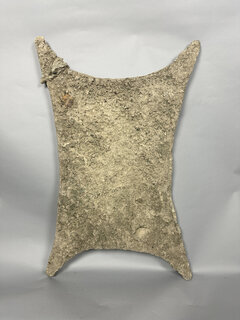| Classical Numismatic Group > Auction 126 | Auction date: 28 May 2024 |
| Lot number: 299 Price realized: This lot is for sale in an upcoming auction - Bid on this lot  | Show similar lots on CoinArchives Find similar lots in upcoming auctions on |
| Lot description: CYPRUS. Late bronze age, circa 1600-1000 BC. Copper ingot in the shape of an oxhide (79x52x8cm); 27.4 kg. For a comprehensive study of oxhide tablets, see M. R. Jones, Oxhide Ingots, Copper Production, and the Mediterranean Trade in Copper and Other Metals in the Bronze Age. (Unpublished Masters Dissertation, College Station, TX, Texas A&M, 2007). Brown patina with natural deposits, casting flaw in one corner. As made and intact. Ex Prof. Erwin Richter Collection (Vienna), with a copy of his statement dated 2012; acquired from Galerie Schönbrunn (Vienna), 22 August 1998, with a copy of their invoice; acquired from Dr. Alexander Atanasov Collection (Munich), 1992; acquired from Münchner Münzhandlung Karl Kreß (Otto Helbing Nachf.) (Munich), 1986. The rich mines of the Troodos Mountains in Cyprus were a principal source of copper throughout antiquity. Although oxhide ingots were widely traded and are found today across much of the eastern Mediterranean and Near East, lead isotope analyses have confirmed that most oxhide ingots are from copper sources in Cyprus. Such was the dominance of Cyprus in the metal's production that the late Latin term for the metal (cuprum) and hence our word "copper" are derived from the name of the island. Although copper ingots had long been produced in various shapes, by the Late Bronze Age the oxhide ingot shape became an international standard. Earlier scholars suggested that the shape was designed to resemble an oxhide and was related to the value of an ox, but this seems unlikely. The earliest such ingots do not have well-developed "legs" or handles, indicating that the shape was adopted for some other reason, and in any event the copper in such an ingot was worth far more than an ox. The shape was more probably developed for ease of handling and transport. The handles would have made them particularly convenient for carrying by men or pack animals, and it has been suggested that ingots may have been loaded into side packs slung over an animal's flanks. Such ingots were widely traded throughout the eastern Mediterranean and Near East. At least 130 have been found on terrestrial sites, although most of those are fragmentary. Find spots on land have been as far east as Iraq and as far north as Bavaria. Larger numbers have been found underwater, usually associated with shipwrecks, from as far west as the coast of southern France and as far north as Bulgaria. The largest finds are the 354 complete ingots from the Uluburun shipwreck (c. 1300 BC) and the 34 complete ingots and 17 fragmentary ingots from the Cape Gelidonya wreck (c. 1200 BC), both sites off the south coast of Turkey. The largest land finds have been from the storerooms of Minoan palaces. Oxhide ingots feature widely in the art and texts of the Assyrians, Egyptians, and Mycenaeans. They represented not only the standard form for the essential commodity of the time, but also served as a form of payment, a prestige good for elite gift-exchange and tribute, and as a store of wealth. Oxhide ingots are rarely offered for sale, as the great majority are in museums. CNG handled one specimen previously, over 25 years ago. We have been able to find only two more recent sale records, both for broken examples: one in Gorny & Mosch in 2014 and one in Hermann Historica in 2019. The present complete and intact example represents a once-in-a-generation opportunity. Estimate: 30000 USD |  |



